Ask Ethan: What In The Universe Is A Fast Radio Burst?

This mystery comes in two varieties: repeating and non-repeating. Here’s what we know so far.
Imagine that you were looking out at the distant Universe, watching the stars, galaxies, and the other light-emitting objects you’re used to, when all of a sudden an incredibly powerful flash of light arrived. Lasting only a few milliseconds or even less, for those brief instants, it shone as brightly as the brightest objects in the sky. Then you started to find others: some polarized, others unpolarized; some as one-and-done events, others irregularly repeating, and even one that regularly repeats every 16.35 days. They’re not visible to humans, though. They only appear at radio frequencies. So, what are these mysterious bursts? That’s what Annie Grimes-Patton, wants to know, observing:
My local news station is asking, “What’s out there?” Scientists are receiving a repeating radio pattern signal from space. Can you weigh in, please?
It’s a mystery that’s now 13 years old, and recent observations have us even more puzzled. Here’s what we know about them.
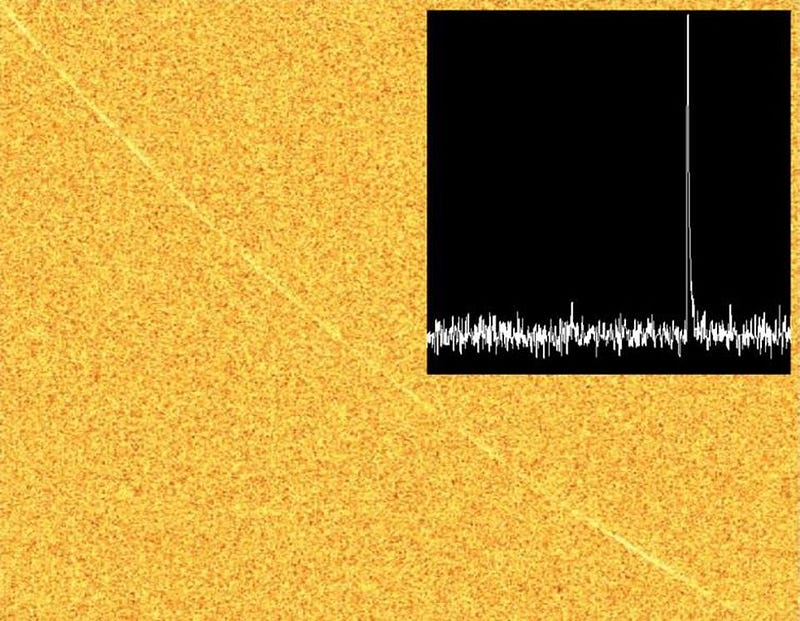
The story began in 2007, when astronomer Duncan Lorimer decided to embark on a project to look through old (archival) data from a radio telescope that was surveying the night sky for pulsars: neutron stars that emit regular pulses each time they complete a rotation. Lorimer’s student, David Narkevic, found a peculiar but highly energetic event from 2001 in the data.
The event corresponded to a “burst” of radio waves that lasted for fewer than 5 milliseconds, but was unlike anything we’d ever seen before. It was located near (but was not associated with) the Small Magellanic Cloud — a small galaxy about 200,000 light-years away from us — and did not repeat, its light was not polarized, and was the only event seen: one millisecond-scale burst in some ~90 hours (324 million milliseconds) of observing.
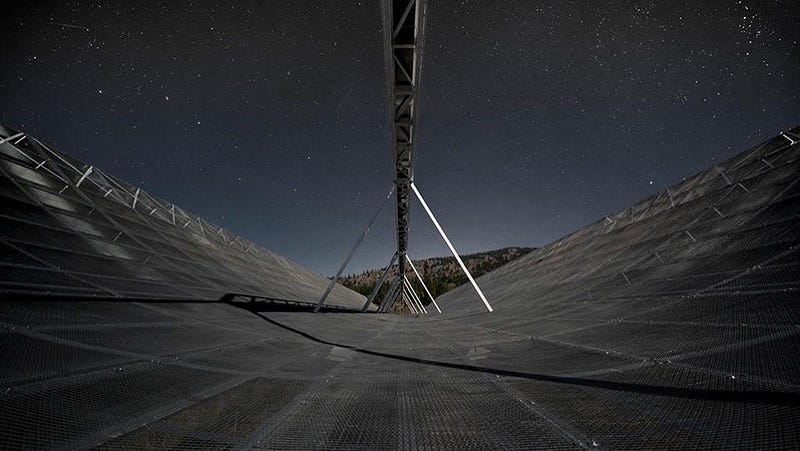
This immediately led to a flurry of new research, as well as speculations about what could have caused the event and how many such events we expect there to be. Lorimer and Narkevic argued that it must have originated from beyond the Local Group, but no more than about 3 billion light-years away; if it were farther, the free electrons in the intergalactic medium would have changed the burst’s observable properties.
Originally, it was suggested that hundreds of these events — now known as Fast Radio Bursts (FRBs) — might occur every day if we were to survey the entire night sky for them; others have since argued that the daily number might be as high as 10,000.
And what could cause them? Perhaps they arise from supernovae, from magnetars, or from the mergers of white dwarfs, neutron stars, or even black holes.
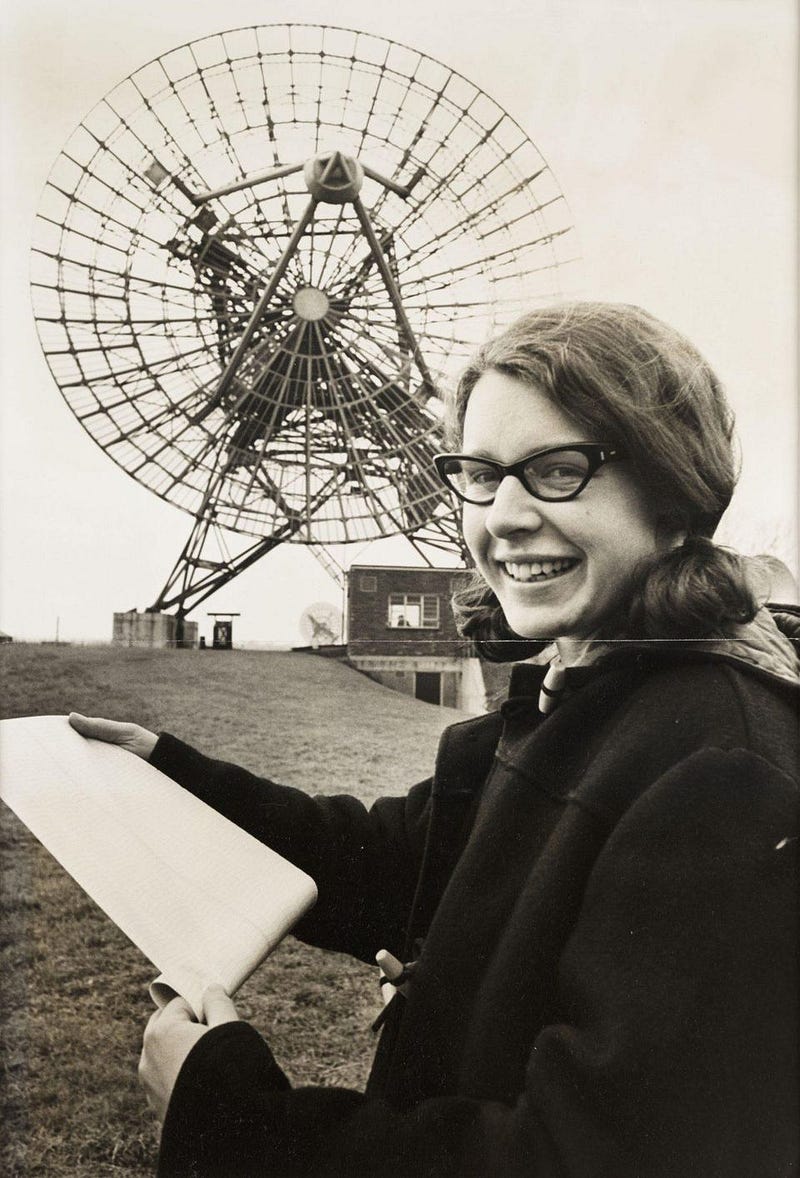
At least, those were our initial thoughts. There was some doubt cast on the entire endeavor in 2010, when the same telescope that detected the first FRB — the Parkes Radio Telescope in Australia — saw a sporadic series of 16 radio pulses that it could not explain. They were given the name “perytons” and were very suspicious: they all looked similar to one another, but not like anything else ever observed in space.
It took nearly five full years to track down the culprit: the microwave oven used by the astronomers at the observatory. When the astronomers, impatient for their heated food, opened the door before stopping the microwave’s power, the microwave oven’s high-powered vacuum tube still generated a signal as it was in the process of turning off. This escaping signal then showed up in the Parkes Telescope’s data, mimicking a fast radio burst.

The peryton signals may not have been coming from the Universe itself, but the FRBs were clearly an entirely different situation. A 2011 burst arrived in the Green Bank Telescope, displaying a property called linear polarization: evidence that it had traveled through a powerful magnetic field. The signal was so significantly dispersed that it must have come from much farther away than the first FRB: up to 6 billion light-years away.
In 2012, a third independent observatory — the Arecibo radio telescope — detected another FRB, measuring an effect known as plasma dispersion. The dispersion was far too large to be consistent with an origin within our galaxy, further indicating that FRBs arise from far beyond our own Milky Way. Many more FRBs were subsequently found, but the real breakthrough came in 2015, again with Arecibo data, where astronomer Paul Scholz identified ten more bursts from this same source: repeating, but irregularly so.
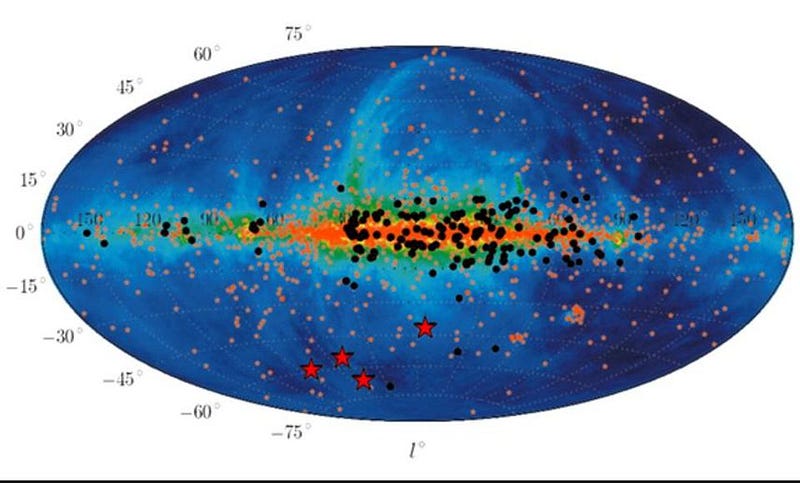
This was the first truly revelatory find. Up until 2015, none of the FRBs had been observed to ever repeat, but this one — known officially as FRB 121102 (meaning it was first discovered on November 2, 2012) — has already repeated dozens of times. The bursts:
- are not periodic; they don’t occur with a regular time-interval spacing between them,
- they all have the same high plasma dispersion of the original burst, indicating that they’re originating from the same extragalactic source,
- the waves are highly polarized, indicating they passed through a hot plasma with a strong magnetic field,
- but cannot be from a one-time cataclysm, like a supernova or a merging system.
What’s even stranger is this fact: it has periods of activity and inactivity. As of June 2020, a 157-day cycle has been revealed: all of the bursts occur within a regular 90-day window, and then there’s always silence over the next 67 days. FRB 121102 continues to burst in this on/off pattern ever since its discovery.

At this point, most of the FRBs we know of appear to be one-time events. A few of them appear to repeat (such as FRB 180814) with a similarly irregular pattern to when they do and don’t pulse. Some of them have been traced to their source: the repeating FRB 121102 was linked, in a 2017 study, to a small-sized galaxy approximately 3 billion light-years away, while the non-repeating FRB 180924 has been linked to a Milky Way-sized galaxy about 3.6 billion light-years away. The closest repeating burst is FRB 180916, hosted by a galaxy just 486 million light-years distant; the most distant is the non-repeating FRB 190523, linked with a single, massive galaxy some 8 billion light-years from us.
The galaxies that are known to host FRBs are very different from one another. They are different sizes, different masses, are forming stars at wildly different rates, and possess different environments in terms of gas, dust, density, and material composition.
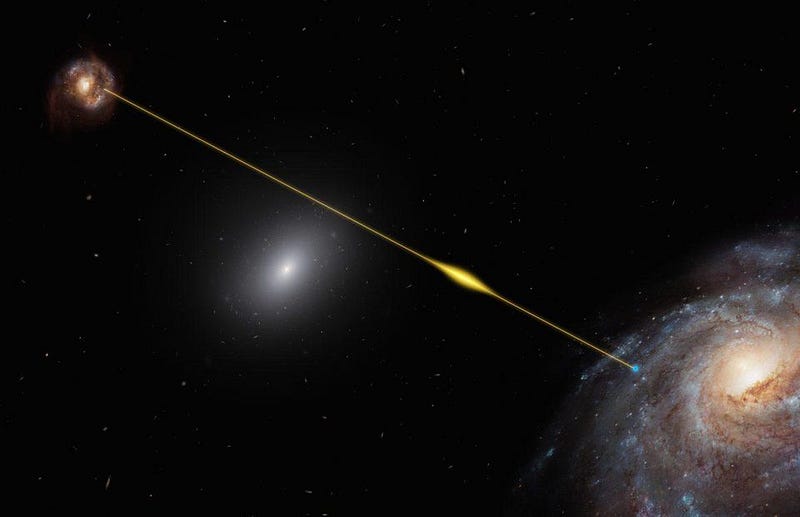
But the strangest Fast Radio Burst of all has to be FRB 180916, which is the only FRB known to repeat with a very regular period. Every 16.35 days, it goes through a cycle of emitting a non-standard pattern of radiation for about 4 days, then remaining silent for approximately 12 days, and then repeating with a slightly different radiation pattern. It’s the mysterious “repeating radio pattern” that has been widely reported this year.
Over a period of less than two decades, we went from:
- not knowing about FRBs at all,
- to thinking they may not even exist,
- to learning that they come in repeating and non-repeating versions,
- to finding that at least some of the repeaters burst (and then don’t burst) in regular, periodic patterns.
The big mystery remaining to be solved is figuring out exactly what’s causing them.
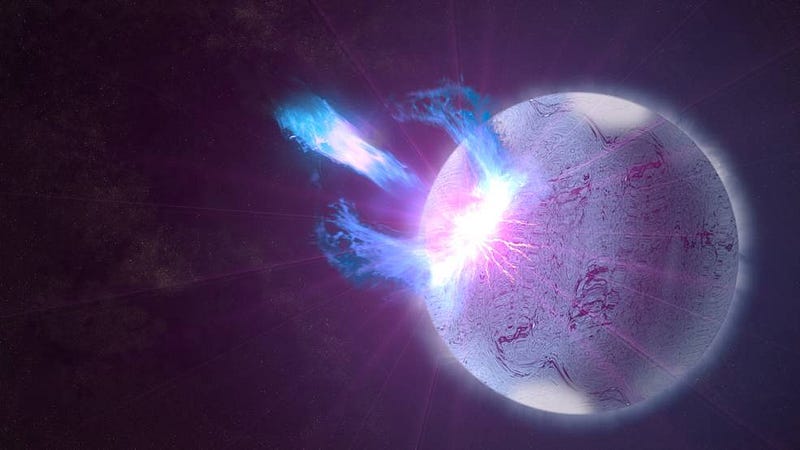
Originally, our thoughts went to spinning neutron stars, because those are already known to “pulse” in the radio part of the spectrum. But almost all of the known pulsars are located in the Milky Way, while only one of the FRBs has likely been tentatively linked to our home galaxy. Repeaters are now known to be quite common, and the repeating sources have the same dispersion properties as the non-repeaters.
However, there is a class of neutron star known as a magnetar: neutron stars with enormously powerful magnetic field, perhaps the strongest in the Universe and up to a quadrillion times stronger than Earth’s magnetic field. This led three scientists — Brian Metzger, Ben Margalit, and Lorenzo Sironi — to come up with a remarkable model that may wind up solving the puzzle: a young magnetar, recently created by a stellar cataclysm, surrounded by the plasma debris from previous ejecta/explosions. When the new ejecta crash into the old debris, a series of pulses, varying in their properties as the blast wave decelerates, get emitted and polarized by the surrounding plasma.

Multiple independent studies have supported the magnetar hypothesis previously for various FRBs, and this new model now brings the repeaters into the fold as a possibility. But there’s still a whole lot left to learn.
Are magnetars the link we need between the repeating and the non-repeating FRBs? Is there a “recharge” period on these magnetars that’s determined by something physical, like an orbiting companion, or perhaps some internal properties? Do they all arise from the same mechanism, or, as with supernovae, are there many ways to make a Fast Radio Burst?
This is what astronomy is like at the frontier of humanity’s knowledge. There are many ideas behind what’s causing these mysterious events, including many very good ideas, but a whole Universe left to explore and understand. Whatever the ultimate culprit may be, further investigations can only lead to increased knowledge and a clearer picture.
Send in your Ask Ethan questions to startswithabang at gmail dot com!
Ethan Siegel is the author of Beyond the Galaxy and Treknology. You can pre-order his third book, currently in development: the Encyclopaedia Cosmologica.




